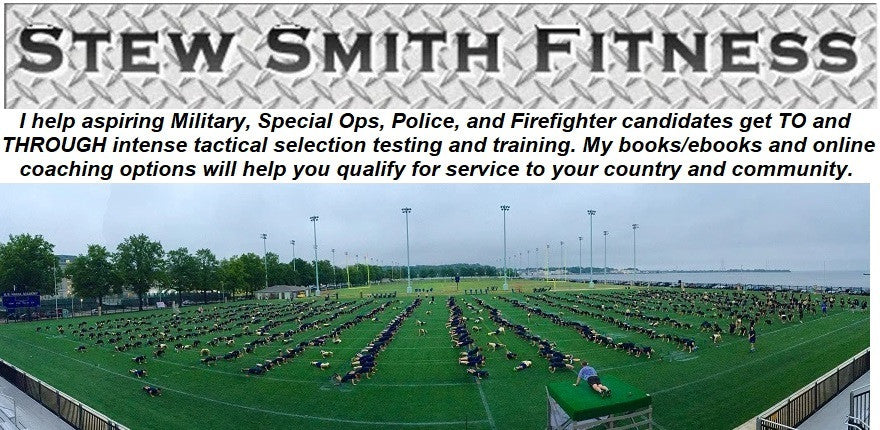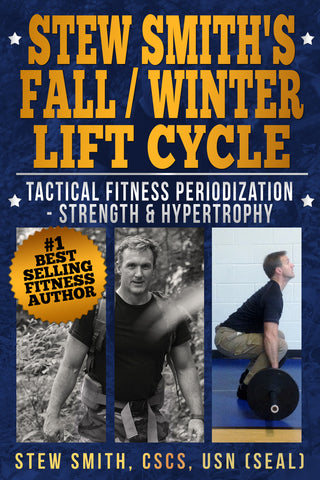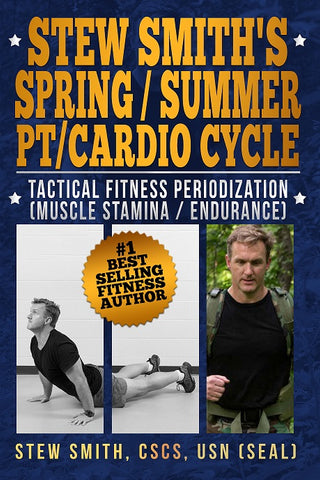Running, Swimming, Lifting Athlete Defined
(more clearly?)

I received this question the other day. I realize I use a variety of terms that I thought go without explanation but let me give a few details when I use the terms "running athlete", "swimming athlete" or "strength/power athlete." All of these athlete types have inherent strengths and weaknesses. An undeveloped weaknesses will be exposed on the first day of spec ops training, basic training, police/fire academies too. In fact, your weakness will be your toughest event when going through any tactical fitness program. Ignore training your weakness at your own peril...
What Do I Mean By Running Athlete? If you spent most of your athletic history (years / decade) focused on getting faster at longer distanced runs and doing sports like track, cross-country, marathon, or endurance races, you would be in my classification as a running athlete. The need for running volume will decrease for this athlete, but it is most likely the need to shorter/faster runs will need to increase.

Weaknesses with Runners - Runners are usually pretty lean, have weaker upper body strength though good with muscle stamina (calisthenics). It does not take long for them to hit advanced numbers on calisthenics portions of fitness tests, but that also depends on their swimming ability. Runners typically have the following weaknesses that coincide with an incredible running ability:
Strength, Power, Speed, Agility - All of these elements of fitness are improved by lifting weights, doing sprints, and changing direction quickly. Obstacle courses can be a challenge to running athletes, if they have not developed some speed and agility along with upper body and grip strength.
Both upper body and lower body weaknesses need to be a focus on training. More time in the weight room and less time running (cut running volume in half) will be requires to make a running athlete more durable for load bearing activities (logs, boats, rucks, equipment, people).
Swimming and shorter faster runs also need some focus to get the running endurance athlete a into faster running pace and into swimming shape. You will be surprised. Runners who can run sub-5 minute pace for 5-10km plus distances still need to get into swimming shape.
Programming Options That Work Best with the Running Athlete:
This series of options build a base of calisthenics first with the first two options to get you to crushing the PST, then the Fall / Winter Lift cycles will help you build mass and strength needed for more load bearing activities in your future:
What Do You Mean by Swimming Athlete?
Chances are the swimming athlete does not need long to learn the CSS. In fact, usually in less than 5 minutes of explaining the CSS, a competitive swimmer who spent years or a decade even perfecting his/her technique can outswim me in the CSS. Time in the pool is a waste for the swimmer, but swimming and treading can be used as a form on non-impact cardio activity that the swimming athlete will likely need.

The impact of running can crush a swimming athlete. In fact, anything the involves gravity will be a challenge at first to the swimming athlete. Stress fractures, shin splints, joint issues (hyper-mobile), and back pain can result if both running and weight lifting training are not progressive with volume increases each week.
Weaknesses with Swimmers - Swimmers are usually pretty lean, have strong arms, chest, and shoulders but often have very mobile shoulders so some shoulder stability training also need a focus. Calisthenics are solid and quickly improved upon, but overall strength is a weakness especially if they never incorporated lifting (and running) during the off-season. It does not take long for them to hit advanced numbers on calisthenics portions of fitness tests, but that also depends on their running ability. Swimmers typically have the following weaknesses that coincide with an incredible ability and comfort in the water:
Strength, Power, Speed, Agility - Swimmers lack some of these, but develop power with kick offs the wall that can translate into lifting in the future. All of these elements of fitness are improved by lifting weights, doing sprints, and changing direction quickly. Obstacle courses can be a challenge to running athletes, if they have not developed some speed and agility along with upper body and grip strength.
Both upper body and lower body weaknesses need to be a focus on training. More time in the weight room and a gentle progression into running is wish. In fact, using the triathlon model where your cardio time is split between running, swimming, and biking, is not a bad idea. Lifting weights will be required to make a swimming athlete more durable for load bearing activities (logs, boats, rucks, equipment, people).
Longer and shorter faster runs - The impact pains of any running needs to be carefully increased each week. Though both zone 2 running and goal pace running will help the swimmer run better. Consider it a running base of training plus faster mile pace running practice done on SOFT ground (turf, rubber track, grass, dirt, sand) will be helpful at first to reduce impact forces compared to running on concrete or asphalt.
Programming Options That Work Best with the Swimming Athlete:
This series build a base of strength training first with the first option that also works with PST prep but lower total volume of running miles. Then the next phase will be a progressive running, higher rep calisthenics and cardio followed by more Winter lifting cycles and progressive running (Spring / Summer) to help you build running volume while maintaining / building mass and strength needed for more load bearing activities in your future:
What Do You Mean By Lifting Athlete?
 18 yr old Stew - Powerlifting / Football Player (not runner, swimmer, PTer)
18 yr old Stew - Powerlifting / Football Player (not runner, swimmer, PTer)
This Athlete is Typically Big, Fast, and Strong - Durability under the load of boats, logs, rucks, people, and equipment is not an issue as this type of athlete will not feel crushed under the strain. Work capacity is a weakness as are running, swimming, grip on obstacle courses, and higher repetition calisthenics, will be the weakness this type of athlete needs to focus on. Basically, calisthenics and cardio. Turning into an endurance athlete is the focus.
Being a bigger athlete typically makes climbing rope, pullups, and other grip related skills a challenge. Running is harder the more you weigh and so are obstacle courses. However, swimming with big rocket fins is one thing that goes well with big weightlifting legs.
Endurance Weakness - This athlete also does well with the triathlon mode of training where you break up cardio activities into thirds with running, swimming, and biking as the impact of just running to build an aerobic base may be too much volume for this type of heavier athlete not used to running miles (at all). In fact, this category is usually in the mindset that a mile is long distance running.
The 50-50 Swim Workout is going to be your GO-TO swim workout along with swimming with fins. Once you master the technique significant training time will be used to get into swimming shape. You may also find swimming helpful to improving run times along with the hard bike workouts added to the week of training.

Get Out of the Weight Room - Chances are, if you spent nearly a decade in the weight room, you do not need to focus on strength when preparing for spec ops / tactical professions. It took some time (12-18 months), but by focusing on endurance and calisthenics, I was able to turn into the type of spec ops candidate that did well through training. However, running was always a weakness that I got to a level that was well within standards but it was never easy.
Programming Options That Work Best with the Lifting Athlete:
This series build a base of endurance and muscle stamina training first with the first option that also works with PST prep but lower to moderate total volume of running miles for athletes new to doing "long distance". Then the next phase will be a progressive running, higher rep calisthenics and cardio followed by more progressive running (Spring / Summer) to help you build running volume and turning yourself into a cardio / PT machine.
So, what is the hardest part of Spec Ops Training? Your Weakness! Your athletic history and preparation focus helps you minimize the challenge.
New Two Part Tactical Fitness Course -
Getting TO and THROUGH Selection
Check out the Stew Smith Fitness Store for more information on what we have available.

Who is Stew Smith CSCS? Coach, Trainer, Writer, Podcaster: I'm the former Navy SEAL that tactical candidates go to for books, ebooks and online coaching to prepare themselves to get to and through intense tactical assessment and selection programs and qualify for service in their chosen tactical profession. See More at StewSmithFitness.com
Special Ops Programming
Military Programming








and many more...
Police and Fire Fighter Programming
General Fitness Programming







and many more...
Home Gym Programming
Personalized Training Programs - Personalized online coaching available too - any fitness level. In fact, most people on the PT CLUB program are over 40 with specific health and fitness goals.
Try Our Stew Smith Fitness Members Only Club - #1 Best Selling Tactical Fitness Programs
 Questions? Just email me at Stew@StewSmith.com
Questions? Just email me at Stew@StewSmith.com
At StewSmith.com - List of Products and Services
- FREE Articles
- Podcasts and Swimming Videos at Youtube.com page
- eBooks
- Books and eBooks in PRINT
- Stew Smith Fitness Club membership site
- Online Coaching



























